Helping Cats Get Needed Dental Care
Kendall Taney, DVM, DAVDC, FAVD, Center for Veterinary Dentistry & Oral Surgery, Gaithersburg, Maryland
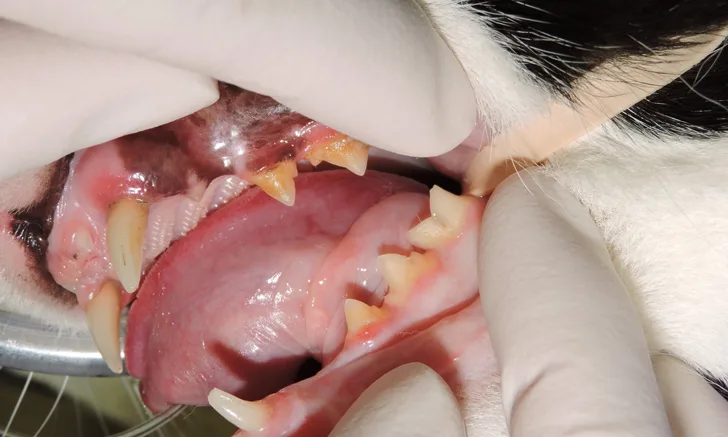
S-O-A-P
Subjective
PRESENTATION: A 5-year-old neutered male, domestic shorthair cat is presented because of his recent change in preference of soft food from dry kibble. The client notes that the kibble bowl was previously empty by the end of the day but now about half of the bowl is still full and the patient is ravenously eating the softer food.
DIET HISTORY: Body weight is stable since the cat’s last visit. The client is not aware of the cat having issues with food in the past or being a picky eater. There have been no diet changes.
MEDICATION & SOCIAL HISTORY: The cat is given monthly topical flea and tick preventative and is current on all vaccinations. He is given no other medications and has had no health concerns. The indoor-only cat is the only household pet. No major life changes have occurred. There is no recent travel history.
Objective
The patient is bright, alert, and responsive.
A limited oral evaluation only was possible because the patient became fractious. The initial evaluation showed:
Missing teeth, although the cat had no history of extractions or trauma
Areas of focal significant gingivitis
Calculus
The remainder of the physical examination was unremarkable.
Assessment
Differential diagnoses for the missing teeth include trauma, impaction, teeth were never present, tooth resorption, and periodontal disease. (See Figure 1.)

The patient is missing teeth, but has no history of previous extractions.
Plan
CBC and serum chemistries will be performed. Pending normal blood work results, the veterinarian recommends general anesthesia to allow for a complete evaluation of the oral cavity and full dental radiographs. Dental scaling and polishing will be performed, followed by treatment of any dental problem under the same anesthesia. Extraction will be recommended if any tooth resorption is identified. Pain medication will be prescribed if any teeth are extracted.
However, the client is hesitant to move forward with the recommendations for her cat for several reasons, including the fact that she feels he is doing well at home and he prefers soft food because it tastes better. He is not losing weight, and he hates being at the practice. The client is also hesitant because a neighbor’s cat died while under anesthesia for a dental cleaning.
Client Communication
The veterinary team will need to reassure the client and discuss dental disease, and the reasons for and details of the recommended procedures. (See Resources.) Use the following responses to address her concerns.
Discussion: Dental health and its importance to overall health
Client's concern: The cat’s teeth must not bother him because he is still eating.
Veterinary team: Explain that is common for pets to continue eating, despite oral pain; that dental disease progresses slowly; and how animals will compensate for their discomfort by eating less dry food or by trying to shift the food in their mouth, indicated by food being dropped.
Discussion: The entire procedure in detail, including risks and precautions
Client’s concern: Her neighbor’s cat died under anesthesia
Veterinary team: Advise the client that such complications are rare and emphasize again the care her cat will receive.
Discussion: The suspected dental pathology, the pain associated with tooth resorption, and how extraction will alleviate the pain and the potential for a tooth root abscess
Client’s concern: Her cat needs those teeth
Veterinary team: Explain the differences between humans and animals and how they use their teeth. Also, explain that humans and domesticated animals chew differently; animals will chew more deliberately and slowly without painful or diseased teeth. Assure the client that the goal is to leave her cat with only healthy, comfortable, and functional teeth. Show her images of tooth resorption grossly and on dental radiographs so she can see that her cat’s teeth are not normal, which will help her accept the team’s recommendations. (See Figures 2 and 3.)
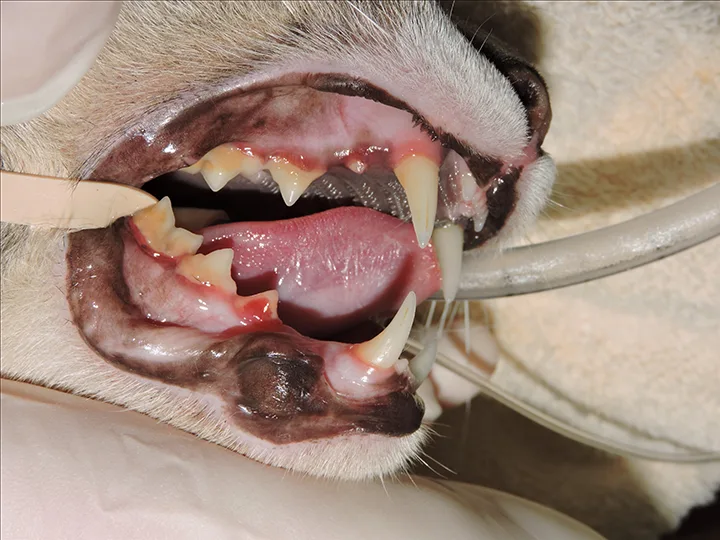
A gross resorptive lesion affecting the right mandibular third premolar
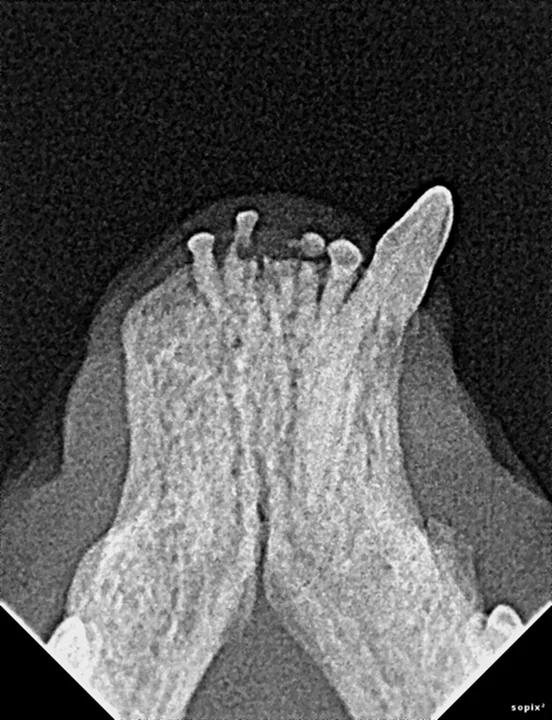
Tooth resorption appearance on a radiograph
Discussion: The initial treatment estimate, describing the importance of each step, including dental radiographs
Client’s concern: The necessity of expensive radiographs
Veterinary team: Advise the client that the root structure and presence or absence of teeth can be assessed only with radiographs, which are especially important for tooth resorption because not all lesions are visible grossly.
The Takeaway
Diagnosis
The cat’s blood work results are unremarkable. A diagnosis of tooth resorption is documented.
Treatment
The client decides to schedule the procedure. The veterinary team will give the client:
Pre-operation requirements, including instructions not to feed her cat for 8 hours before the procedure
An explanation of the anticipated costs from a veterinarian or a veterinary team member before the procedure
The tentative timeframe for the procedure, followed by updates if there are delays
A second explanation of the costs and specific treatment recommendations after dental radiographs have been taken and the oral examination is complete
An update of the timeline of the procedure, including the expectation that her cat will be in recovery for 60 to 90 minutes
Notice that the procedure has been completed
A time for the client to pick up her cat and receive home-care instructions
Post-Treatment
When the client arrives to pick up her cat, she is taken to an examination room for an explanation of the discharge instructions. The veterinarian shows her before and after images of the cat’s teeth; providing visual evidence will go a long way to assure the client she made the right decision to pursue treatment. (See Figures 4 and 5.)
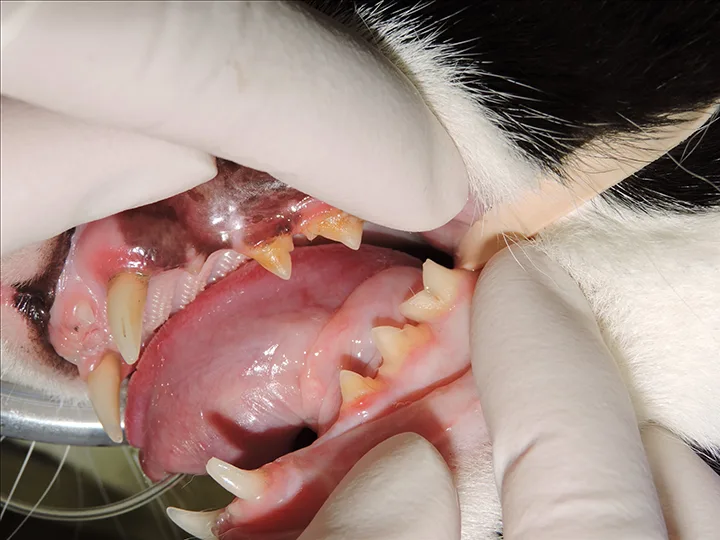
Pre-operative image of the left maxilla and mandible
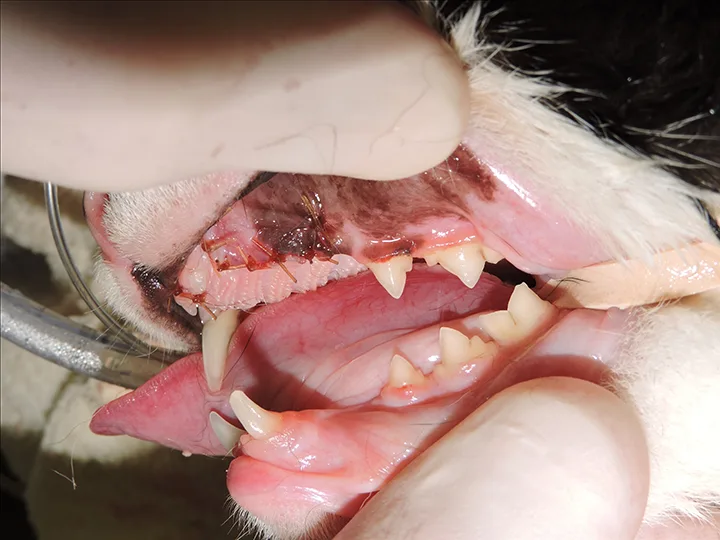
After extraction, closure, scaling, and polishing
The veterinary team will also:
Provide written care instructions that will be discussed with the client so she feels comfortable with what to expect while her cat is recovering from this procedure. Discuss how the cat may act after anesthesia, any precautions that should be taken, what food can be given and when the patient can be fed, directions for all medications prescribed, and a contact number if the client needs help.
Ensure the patient is clean, dry, and presentable.
Call to check on the patient either the evening of discharge or the following morning.
Make follow-up calls until the client is comfortable that her cat is recovering.
Schedule a progress appointment for 14 days after the procedure.
Progress Examination
The veterinarian evaluates the surgical sites. A team member discusses instituting a dental home-care program, and sets up an appointment for the cat’s next dental evaluation.
The client is happy with her cat’s recovery and for the follow-up care the veterinary team provided. She thinks her cat is more active and social. Key to the client’s satisfaction is the veterinary team’s constant communication that addressed every client concern.
Photos courtesy of Kendall Taney, DVM, DAVDC, FAVD